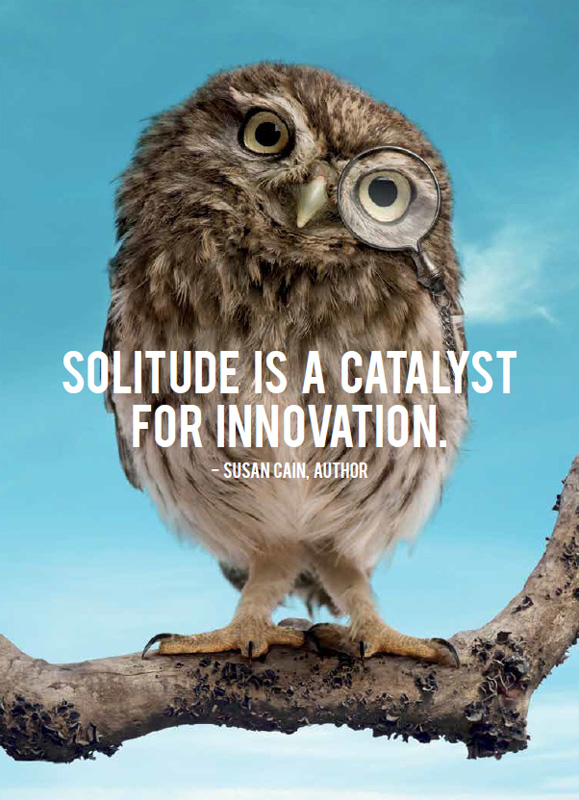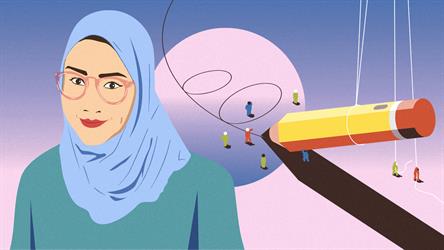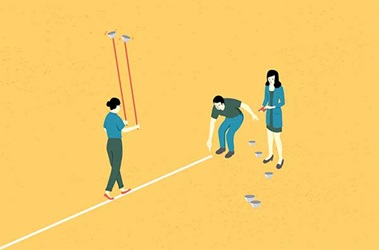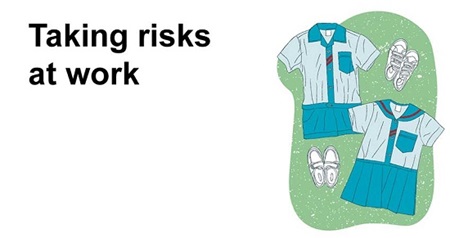Surprising Elements of Innovation: Chance, Chaos, Sleep, Solitude And Videos
5 things you never thought could make you innovative.

Are Singaporeans innovative? A recent study of innovation in Asia says we are not doing too badly – but we “could be achieving even more”. The analysis, which was jointly conducted by the Economist Intelligence Unit and the Asian Development Bank last year, ranked Singapore eighth out of 22 Asian economies in a Creative Productivity Index.
It noted that while we topped the region in having the best capacity, incentives and environment to promote innovation, we were sixth in creative output, which covered, for instance, the number of books and films issued and patents filed. That means we are less efficient in turning our creative input into output.
How then might we go about achieving more innovation?
According to Shawn Hunter, who wrote Out Think: How Innovative Leaders Drive Exceptional Outcomes, innovation is the act of implementing or creating something new with value. It is different from creativity, which Hunter defines as the ability to think up something original or unusual. The Harvard Business Review and Business Insider also define innovation as applying solutions to problems and introducing newness into stable systems.
Within the Singapore Public Service, the 2014 PS21 ExCEL Innovation Champions have shown that innovation can occur not only in the form of new inventions that fill a gap, but also as small but novel process improvements that make a big impact. And unlike for creativity, which is more intangible, there seems a consensus that innovation is a mindset that can be cultivated in any individual or organisation.
With that in mind, Challenge has set out to explore five big catalysts of innovation: chance, chaos, sleep, solitude and videos. We hope the following pages will not only offer ample food for thought, but inspire you too to take up the innovation challenge.


CHANCE: Innovation starts with you
Dr Richard Wiseman, head of psychology research at the University of Hertfordshire, can tell if a person is lucky with a simple experiment. He hands participants a newspaper and asks them to count the number of photos printed in it. A few people finish the task at once while others take much longer. Why? The first group spotted a large headline on page two that spelled out the answer, whereas the latter focused so doggedly on counting the photos that they totally missed that chance.
The test shows that lucky people are often open to random opportunities even when they’re working on other tasks. Luck, Dr Wiseman writes in his book The Luck Factor, is a state of mind, a way of thinking and behaving. He believes everyone can create good or bad luck by the actions they take when confronted with chance events.
In a decade-long study, Dr Wiseman found that “lucky” people share similar traits: They always look on the bright side of every situation, act on chance encounters instead of letting them slip by, listen to their hunches and persevere in the face of failure.
When it comes to innovation, these traits make lucky people best positioned to learn from failure and connect disparate information to come up with novel solutions. Many innovations seemingly arise by chance, such as the Slinky toy. But if its inventor, an engineer tasked to develop springs for ships, had not recognised the entertainment value of a wobbly spring after he accidentally knocked one over, the toy would not exist.
Ms Lizi Hamer, creative director of Arcade network, said in a Creative Mornings talk that acting on random encounters has helped her shape award winning advertising campaigns. But citing the “iceberg effect”, she added that beneath every a-ha! moment is hard work, years of experience and a gut feel to filter valued signals from all the randomness out there.
Dr Phua Chee Teck, a lecturer at Nanyang Polytechnic, also believes in a kind of beginner’s luck: He gets his students to join the Tan Kah Kee Young Inventors’ Award competition every year. “I use this as a platform to nurture their innovative minds. In the process, I will also get ‘fresh’ ideas from them,” he says.
So finding breakthroughs starts with having a mindset of “making your own luck”. But if that is not enough to first put randomness into your routine, the following section will show how introducing some chaos in your life can boost innovation.

CHAOS: Leaving innovation in its path
The US Army, as a military organisation, is sure to be regimented. Yet, following the aftermath of 9/11, it welcomed chaos into its rigidity through a haphazard training programme.
In week-long sessions, busy officers dropped their duties and sat in circles to talk about anything they could think of to improve the Army. Far from wasting time, these unstructured sessions led hundreds of officers to generate new ideas that could help address problems plaguing the military.
Just like the US Army, structured organisations looking to boost innovation could benefit from embracing some “organised chaos”, argues organisational expert Ori Brafman, author of The Chaos Imperative: How Chance and Disruption Increase Innovation, Effectiveness and Success.
He says the trick to minimising the risk of havoc is to contain key elements of chaos within boundaries to form “pockets of chaos”. The key elements include having white space (also known as unstructured time), unusual suspects and organised serendipity.
White space is where structure and efficiency – which can snuff out innovation – are put aside. “We need white space in order to avoid becoming so task-focused that we lose our creativity,” says Brafman.
Republic of Singapore Air Force (RSAF) Military Expert 5 (ME5) Liu Jianlin introduced iFocus time – an hour every three months – for servicemen in his unit to concentrate on ideas and projects to improve productivity. As his unit’s Innovation Officer, he realised that his colleagues were too focused on operations to make time for innovation.
“If the management doesn’t give our people the resources to innovate, which in this case is time, then they will say that they have no time,” he says. There are no concrete results from this new initiative yet, but ME5 Liu observes that some staff continue to work on their ideas beyond the designated hour.
A second way to introduce chaos is to work with unusual suspects – people who are not usually involved in a certain project or field. These individuals, from within or outside the organisation, could bring in new perspectives.
In Singapore, one relatively new way to encourage inter-agency collaboration is through “hackathon”-style workshops, where officers come together to brainstorm solutions to another organisation’s challenges.
Last November, the Land Transport Authority (LTA) and the Public Service Division organised a Ha-Co-thon (which stands for Happy Commuters Make-athon). The three-day workshop roped in officers from various agencies to help the LTA create a happier public transport experience for the elderly and families with young children.
Participant Daniel Leong, a planner from the Urban Redevelopment Authority, worked with officers from the Singapore Police Force, Sport Singapore and the LTA. His team discovered that “although most families … try to keep [their children] quiet, children’s behaviours can also be a source of delight and surprise for other commuters”.
The third element of chaos is to have organised serendipity by encouraging spontaneous interactions between people who do not usually interact.
The Dutch government has an online system for public servants to reserve and use office spaces that are set aside in the buildings of other government agencies. Named Deelstoel (“share chair” in Dutch), this initiative encourages public employees to share not just workspaces but also ideas and expertise.
But an essential point to remember when introducing chaos into an organisation is to strike a balance between order and chaos, writes VISA founder Dee Hock in his book Birth of the Chaordic Age. Only then can groundbreaking ideas develop into practical solutions.
SLEEP: What has getting enough sleep got to do with creativity?
When we don’t sleep enough*, it feels like our minds are in a fog. That’s the brain getting tipsy. Studies confirm that after 10 hours of being awake, every additional hour awake is equivalent to an increase of 0.004% blood alcohol concentration.
Experiments also show that our ability to think creatively, and hence be innovative, takes a hit. “Sleep deprivation has a pretty negative effect on the ability to think flexibly and innovatively… When sleep-deprived, people seem to have difficulty incorporating new information to come up with novel or better solutions,” says Dr William Killgore, a neurophysicist at the University of Arizona who studies the effects of sleep deprivation on cognition, including creativity.
But the jury’s still out on an absolute link between sleep deprivation and creativity. Many factors have yet to be studied, such as gender and age.
Due to funding priorities, sleep research has focused on life- or health-threatening effects of sleep deprivation, says Dr Killgore. Researchers have drawn links between a lack of sleep and brain tissue loss, increased hunger, and elevated risks of cancer, stroke, diabetes and heart disease. Sleep also aids the brain to wash away toxic build-up that includes Alzheimer’scausing proteins.
Still, there are outliers who do benefit from sleep deprivation. Local author Ms Melanie Lee conjured up the quirky characters of her book Imaginary Friends during a period of interrupted sleep. “I think because I was in this trippy state, my ‘inner critic’ went into a coma,” she says, “and that [gave] me more freedom to explore possibilities.
“I think creativity fares better when you’re a little sleep-deprived compared to being very sleep-deprived.” So if you’ve been chronically sleep-deprived and feeling a little dry creatively, why not try sleeping a little earlier and a little more? If nothing else, it should still improve your health and possibly stave off Alzheimer’s.
*In 2014, Singapore was named the third most sleep-deprived city in the world, with residents clocking 6 hours 32 minutes of sleep daily.

SOLITUDE: “Leave me alone, first!”
Obviously, there are benefits in working together. But it’s never a one-size-fits-all solution. One can’t ignore the possibility that in a big organisation like the Public Service where there are introverts, some people will find brainstorming with others counter-productive.
Jennifer B. Kahnweiler, author of Quiet Influence: The Introvert’s Guide to Making a Difference, makes a resounding case for why innovating in teams may backfire for introverts: “Not only does being intertwined with others deplete their reserves of people energy, it also takes them away from the physical and intellectual space, where they do their best thinking.”
Kahnweiler goes as far as to say that solitude is the key to unlocking creativity in introverts. “Your right brain, the side that is more unstructured, experimental, creative, visionary, and less orderly, has a chance to work to a fuller capacity when you are in a relaxed state.”
Susan Cain, who penned Quiet: The Power of Introverts in a World That Can’t Stop Talking, agrees. The tendency of the louder ones to take charge while their softer counterparts back off, and “the fear of looking stupid in front of one’s peers”, says Cain, are reasons why group brainstorming could snuff out creativity.
The RSAF’s ME5 Liu is well aware of this. During his unit’s iFocus sessions, he encourages his staff to write their ideas on paper, which will then be displayed on a board. This makes sure that everyone gets heard.
A fixation with collaboration also matters in the design of the physical workspace. Cain argues that while collaboration may work well in the virtual arena (think the open-source Wikipedia and Linux), it may flop in reality. While online interactions are “asynchronous, relatively anonymous” and hence allow people to work on their innovations without distractions, face-to-face exchanges in an open-plan office could be limiting, especially if fraught with office politics. Thus the logic for an open, physical environment – if merely based on the success of open-source spaces online – could be unsound.
Instead, she suggests that offices have “flexible” arrangements that allow for both solo and socialising spaces. In this way, teamwork can still flourish while those who crave privacy can have the quiet haven they need to focus on their work.
Other researchers, according to a New York Times blogpost, have found that working with a moderate level of ambient noise (“the whoosh of espresso machines and caffeinated chatter typical of most coffee shops”) is useful for anyone looking to concentrate and broaden his mind.
So if you’re one who wants some solitude without being alone, try that cafe near your office.
VIDEOS: Watch, create, share
For Mr Shafiq Ali, founder of 3-D printing company Méká, it was a video of a 3-D printer in action that kick-started his passion for the technology. Like him, makers all over the world draw inspiration and learn to create or fix things from watching videos, a medium often used by maker communities to showcase their craft.
Online videos are accelerating innovation globally in many fields including education, science and dance, says TED curator Chris Anderson. The mechanism is simple: Web videos show people what others around the world can achieve, motivating the viewers to be just as good, if not even better than what they have seen. Many viewers then create their own videos too, in turn inspiring others.
Chestnut Drive Secondary School’s Head of Infocomm Technology, Ms Chen Siyun, says that students not only enjoy watching videos in class, they also choose to create them for assignments. An inter-school portal called iMTL already allows students to upload clips of themselves speaking in their mother tongue for peers and teachers to comment on. Ms Chen thinks a video-sharing platform where more types of student-created content can be shared across schools would be useful, and tells that the Ministry of Education is developing a new online learning space for students.
In the scientific field, the Journal of Visualised Experiments (JoVE.com) lets scientists publish their peer-reviewed research on video, making it easier for others to replicate experiments than when complex steps are described only in print.
In Mr Anderson’s TED talk, “How Web video powers global innovation”, he says organisations can use videos to spark their own cycles of innovation.
But for that to succeed, being willing to share your ideas with a crowd is crucial. As he puts it: “It’s by giving away what you think is your deepest secret that maybe millions of people are empowered to help improve it.”
Watch Mr Anderson’s TED talk.
- POSTED ON
Jan 12, 2015
- TEXT BY
Bridgette See, Siti Maziah Masramil, Chen Jing Ting and Tay Qiao Wei
-
Deep Dive
Strengthening Singapore’s Food Security
-
Deep Dive
Seeing Risk Differently
-
Your Say
Taking Risks At Work











